Hey guys,
First, let's get some general info out of the way that helps understand where I'm coming from with this review:
Wrist size: 6.5 - 6.7 inches
Current collection:
Rolex 16710 GMT Master
Rolex 116523 Daytona
Previously owned Watches for comparison:
Doxa 50th Anniversary Silver Lung
Rolex 116600 SeaDweller (40mm)
Rolex 16610 Submariner Date
Rolex 14060 Submariner
Rolex 116710 BLNR
Tudor Black Bay 58
What I was looking for: A quality diver, that wasn't a Rolex, with a good heritage to go in my collection.
What I like: Proportional watches on my wrist. Usually on the sub 40mm size or watches with short Lug-to-lug measurements.
I loved my Silver Lung when I owned it. It was one of my favorite watches to wear. Things happen and I needed to thin the collection and it had to go. So when Doxa released their 2020 models of the 300 in non-limited production, I knew I wanted to get one.
![Image]()
I purchased the 300 professional first and it arrived earlier this week. But as I was looking at the forums I came across this post: DOXA 300T Divingstar - Unboxing and use about the 300t Divingstar. Something about it really caught my eye, so I ended up purchasing both with the intention of moving on from the one which I liked least.
With that said, here's a quick review. I'll try to keep things brief but I know this forum is one of the few sources of information about Doxa on the internet people have before making a purchase decision, so I'll try to give concise details.
Price:
300: $2450 USD
300t: $1850 USD
Packaging:
Retail packaging, plastics and accessories are the same.
Initial impressions:
The 300 arrived first, my initial impressions were just as I expected since I've owned one before; the watch head is solid, well made and lighter weight than it looks.
Next came the 300t. Right out of the box the watch felt heavier and much more "solid". Both the case and bracelet weight more than the 300 and it's very noticeable. The lines and corners also feel "sharper" - Hard to really describe unless you handle but that's the best way to explain.
Bracelet and Clasp:
The 300 bracelet is lightweight and has more of that vintage "rattle" that people who've owned 5 vs 6 digit Rolex Professional models will know what I mean. The clasp of the 300 is your typical stamped metal flip lock clasp like came on the reissued models. It snaps solid shut and has micro adjustments in the clasp. The divers extension is folded metal which flips outward from the inside of the clasp. Again, think 5 digit Submariners.
![Image]()
The 300t bracelet is thicker and tighter than the 300. Those two qualities make it feel more premium in the hand. The clasp forgoes the flip lock for a twin action trigger system. The clasp, like the bracelet, is thicker, machine milled and features an on the go adjustment system/divers extension which does not need to be removed from the wrist to use. There are no micro adjustments in the clasp. While the clasp is thicker, it's not that much thicker (like the Rolex Glidelock is compared to the old flip locks.) that it's uncomfortable or obtrusive (IMHO the Rolex glidelocks are both).
![Image]()
Case/watch head:
The 300 and 300t share the same dimensions on paper in terms of lug-to-lug and diameter. At 44.5 mm lug-to-lug, neither spill off the wrist. One of my main attractions to Doxa in general.
Where things differ is the rest. The 300t has a thinker case due to the HRV and therefore does make the watch heaver. The 300 has a lighter case and it's noticeable in hand, BUT not as much on wrist. The dial of the 300 is smaller than the 300t and the 300 has a domed crystal which gives that vintage distortion at certain viewing angles. The 300t has a larger dial and flat crystal. The crowns have different milling patterns, the 300t is easier to grip and wind (I'll get into specifics later). The 300t offers a little more room between the case and the bezel due to thickness, that makes the bezel much easier to grip and turn. But both bezels have the same super solid action with no play at all.
300 features a meters dive table on the bezel while 300t has feet.
![15484233 15484233]()
![15484235 15484235]()
![15484238 15484238]()
![15484243 15484243]()
![15484244 15484244]()
Dials:
This one here is hard because I got two different dial colors. So I'll stick with everything other than the colors.
300t has a larger dial, hands and lume plots. The 300 has greenish lume while the 300t has blue lume. The 300t glows much brighter than the 300. Not sure if it's due to the larger plots or different types of lume, but it's noticeable.
![15484231 15484231]()
![Image]()
Movement / Winding:
I initially really wanted a 300 because the movement is COSC certified but both feature the exact same ETA movement 2824-2. From what I've gathered in the time with them, they both keep roughly the same time in terms of accuracy.
Let's talk about the winding and setting mechanism because this is where I did notice a difference. The 300t felt much more solid unscrewing, winding, moving the crown positioning and setting. I don't know if this is due to Doxa using a different crown locking system for the 1200 meter water resistance or if it's the different crown? Since the movement is the same, my assumption is that it comes down to one or both of the things I just mentioned. But it feels much more solid. The 300 crown gives an ever so slight "wobble" or "lateral play" when winding, moving positions and setting. My Silver Lung felt the same, so again I think it's the construction and not the movement. The 300 play is barely noticeable and shouldn't deter you at all, but just something I've observed.
Fit on the wrist:
The 300 fits great. It's light weight, barely noticeable and easily slips under the cuff because of the slimmer case and domed crystal. The short lug-to-lug measurements make this really easy to wear for smaller sized wrists and even though the case is 42mm, it wears better than some 40mm watches (ie: chunky 6 digit Rolex subs and GMTs). The smaller dial give it the impression that it is smaller, and the relatively flat caseback keeps it low on the wrist. The bracelet has hinged middle links, which makes the bracelet wrap nicely around the wrist. However, because of this, at times when you look down at your wrist it has this weird flat-top look in my wrist. I'll try to capture this in a photo, but it can look a little weird. (I only bring this up because of different bracelet on the 300t which doesn't give this look.)
While the 300t has the same case lug-to-lug and diameter, it wears different. First, the 300t feels more balanced when looking directly head on. The larger dial and flat crystal for some reason makes it look more balanced or rounded, and the end links of the bracelet (which aren't hinged and are solid and flared out) actually make it look more tapered and again, balanced on the wrist. I know the endlinks were a point of contention with some people and they didn't like the way it looked, but to me, it actually balances the watch out and makes it so you never see that odd flat-top look. The extra thickness and weight are only slightly noticeable first time on wrist. But the heavier bracelet and clasp quickly balance things out the head and it becomes just as unnoticeable and comfortable as the 300 after a little while of wearing.
![Image]()

![15484246 15484246]()
![15484248 15484248]()
![15484249 15484249]()
![15484250 15484250]()
![15484251 15484251]()
![15484253 15484253]()
Conclusion:
Both the 300 and 300t are fantastic watches and have a lot to offer from Doxa. If one catches your eye over the other, you couldn't go wrong with either choice. I'm 100% in the buy what you love camp.
But let me focus on pricing for a minute because I didn't even give it a thought until I handled both. The 300t has a lot more to offer for the money. It's $600 less and I could convincingly make the case that it's a much better and more capable watch. IMHO, you're paying extra just for a COSC certification but I would argue that you're not paying just $600 more for it, you're paying probably $1000 more for it. Let me explain, COSC certification is the only thing that's technically "better" than the 300t. The bracelet, HRV+depth rating, clasp, lume, are all hands down better features of the T plus it has the same movement. So take COSC away and theoretically shouldn't the 300 cost less than the 300t? Doxa does have some weird pricing, and this here is a perfect example. Bottom line - for the price the 300t is a steal.
For me, the 300t is the clear winner after a few days of wearing both non-stop. The price coupled with the better construction/quality make it an obvious choice for me. I understand if the endlinks are a dealbreaker for some with smaller wrists, and if that's your issue, then spending an extra $600 for a watch you'll love and really want is a small price to pay. For me I'll be keeping the 300t and I'll make a decision about what to do with the 300 at a later date. I think keeping both in a collection is certainly an option because they are different.
Kudos to Doxa. You've made a more wearable and unique alternative for people who want a capable dive watch like the Rolex SeaDweller but for a fraction of the price.
Thanks for reading! Feel free to post questions and if you want any additional photos I may not have provided.

![15484254 15484254]()
![15484255 15484255]()
Sent from my iPhone using Tapatalk
First, let's get some general info out of the way that helps understand where I'm coming from with this review:
Wrist size: 6.5 - 6.7 inches
Current collection:
Rolex 16710 GMT Master
Rolex 116523 Daytona
Previously owned Watches for comparison:
Doxa 50th Anniversary Silver Lung
Rolex 116600 SeaDweller (40mm)
Rolex 16610 Submariner Date
Rolex 14060 Submariner
Rolex 116710 BLNR
Tudor Black Bay 58
What I was looking for: A quality diver, that wasn't a Rolex, with a good heritage to go in my collection.
What I like: Proportional watches on my wrist. Usually on the sub 40mm size or watches with short Lug-to-lug measurements.
I loved my Silver Lung when I owned it. It was one of my favorite watches to wear. Things happen and I needed to thin the collection and it had to go. So when Doxa released their 2020 models of the 300 in non-limited production, I knew I wanted to get one.
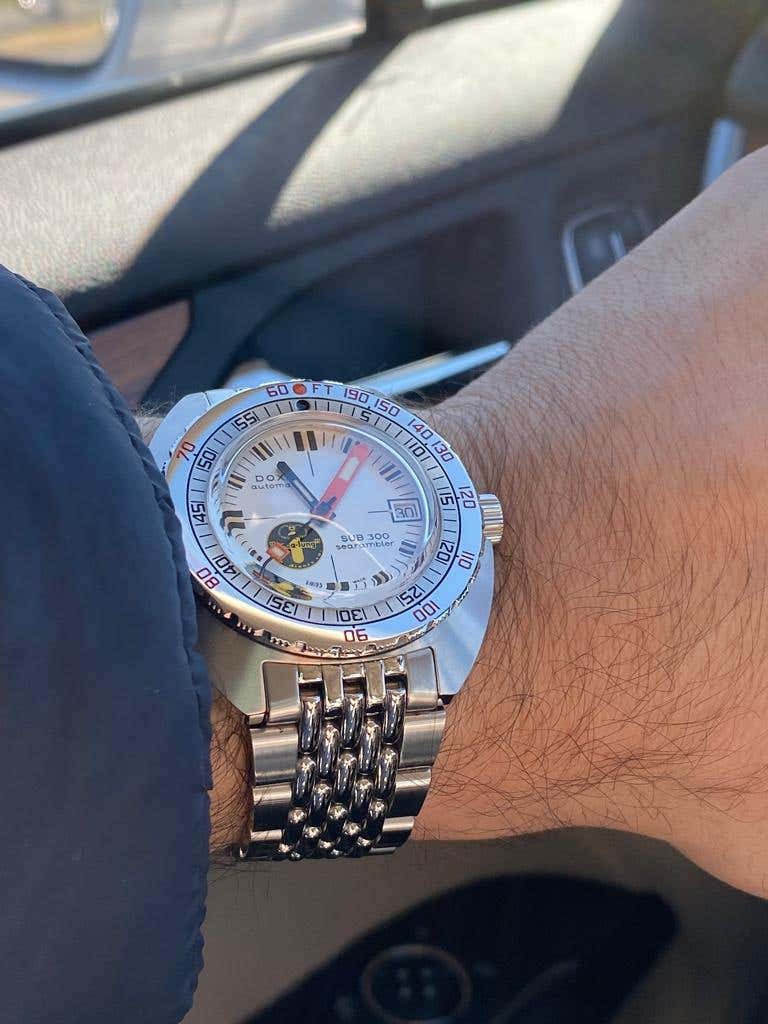
I purchased the 300 professional first and it arrived earlier this week. But as I was looking at the forums I came across this post: DOXA 300T Divingstar - Unboxing and use about the 300t Divingstar. Something about it really caught my eye, so I ended up purchasing both with the intention of moving on from the one which I liked least.
With that said, here's a quick review. I'll try to keep things brief but I know this forum is one of the few sources of information about Doxa on the internet people have before making a purchase decision, so I'll try to give concise details.
Price:
300: $2450 USD
300t: $1850 USD
Packaging:
Retail packaging, plastics and accessories are the same.
Initial impressions:
The 300 arrived first, my initial impressions were just as I expected since I've owned one before; the watch head is solid, well made and lighter weight than it looks.
Next came the 300t. Right out of the box the watch felt heavier and much more "solid". Both the case and bracelet weight more than the 300 and it's very noticeable. The lines and corners also feel "sharper" - Hard to really describe unless you handle but that's the best way to explain.
Bracelet and Clasp:
The 300 bracelet is lightweight and has more of that vintage "rattle" that people who've owned 5 vs 6 digit Rolex Professional models will know what I mean. The clasp of the 300 is your typical stamped metal flip lock clasp like came on the reissued models. It snaps solid shut and has micro adjustments in the clasp. The divers extension is folded metal which flips outward from the inside of the clasp. Again, think 5 digit Submariners.
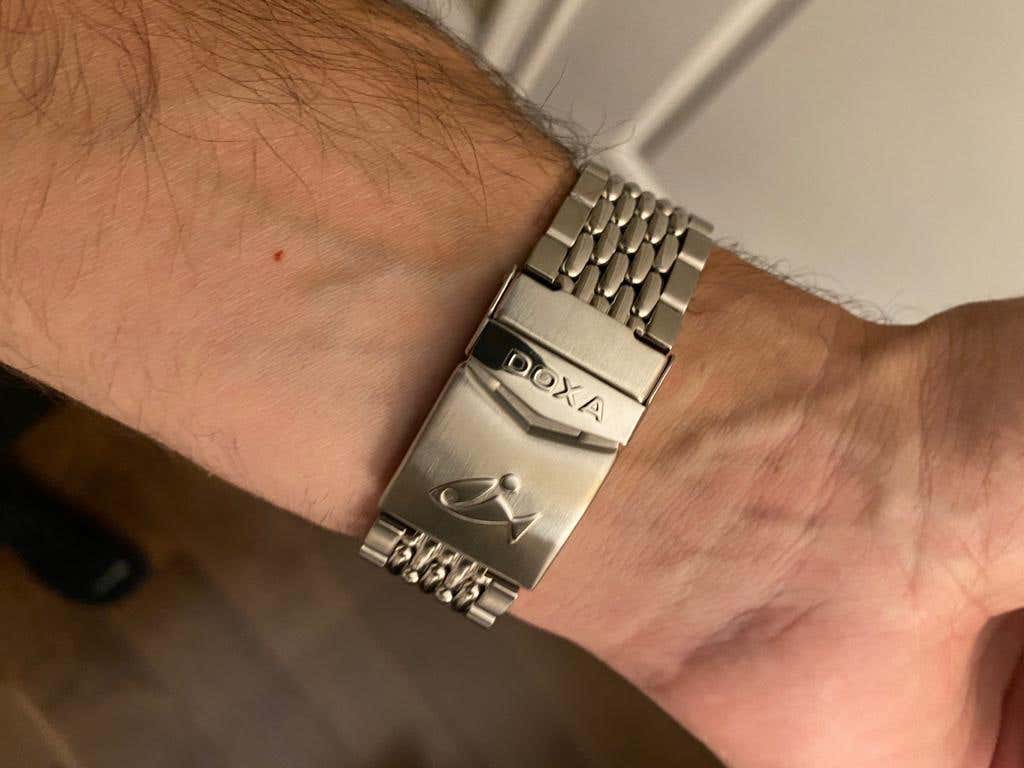
The 300t bracelet is thicker and tighter than the 300. Those two qualities make it feel more premium in the hand. The clasp forgoes the flip lock for a twin action trigger system. The clasp, like the bracelet, is thicker, machine milled and features an on the go adjustment system/divers extension which does not need to be removed from the wrist to use. There are no micro adjustments in the clasp. While the clasp is thicker, it's not that much thicker (like the Rolex Glidelock is compared to the old flip locks.) that it's uncomfortable or obtrusive (IMHO the Rolex glidelocks are both).
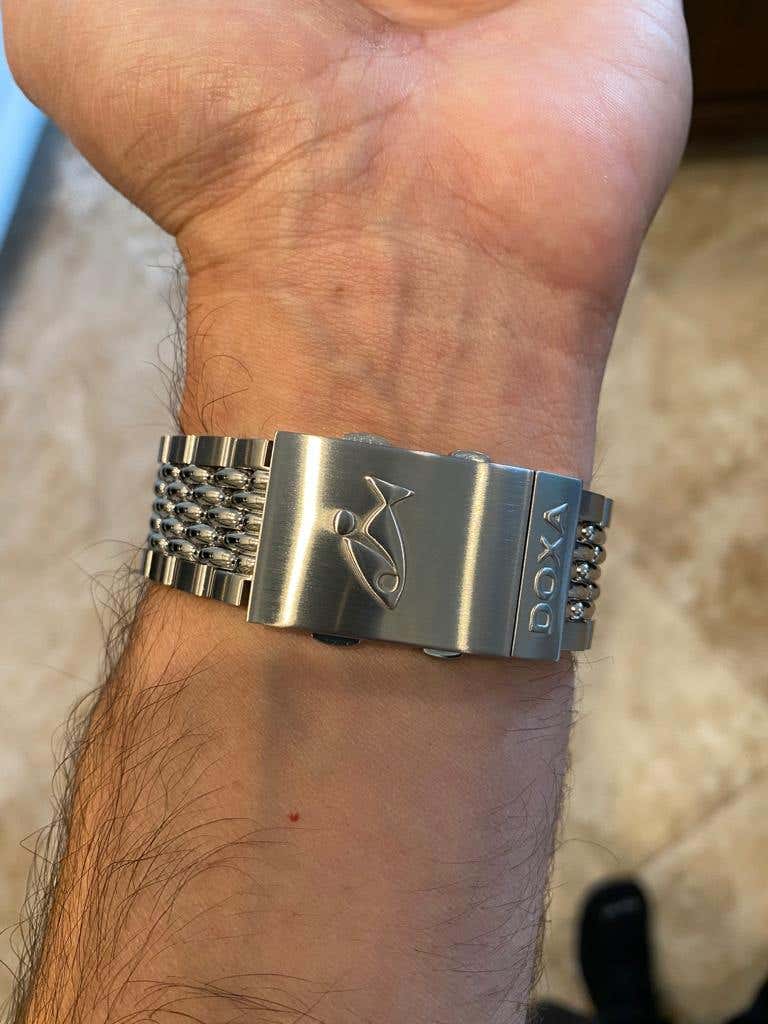
Case/watch head:
The 300 and 300t share the same dimensions on paper in terms of lug-to-lug and diameter. At 44.5 mm lug-to-lug, neither spill off the wrist. One of my main attractions to Doxa in general.
Where things differ is the rest. The 300t has a thinker case due to the HRV and therefore does make the watch heaver. The 300 has a lighter case and it's noticeable in hand, BUT not as much on wrist. The dial of the 300 is smaller than the 300t and the 300 has a domed crystal which gives that vintage distortion at certain viewing angles. The 300t has a larger dial and flat crystal. The crowns have different milling patterns, the 300t is easier to grip and wind (I'll get into specifics later). The 300t offers a little more room between the case and the bezel due to thickness, that makes the bezel much easier to grip and turn. But both bezels have the same super solid action with no play at all.
300 features a meters dive table on the bezel while 300t has feet.
Dials:
This one here is hard because I got two different dial colors. So I'll stick with everything other than the colors.
300t has a larger dial, hands and lume plots. The 300 has greenish lume while the 300t has blue lume. The 300t glows much brighter than the 300. Not sure if it's due to the larger plots or different types of lume, but it's noticeable.
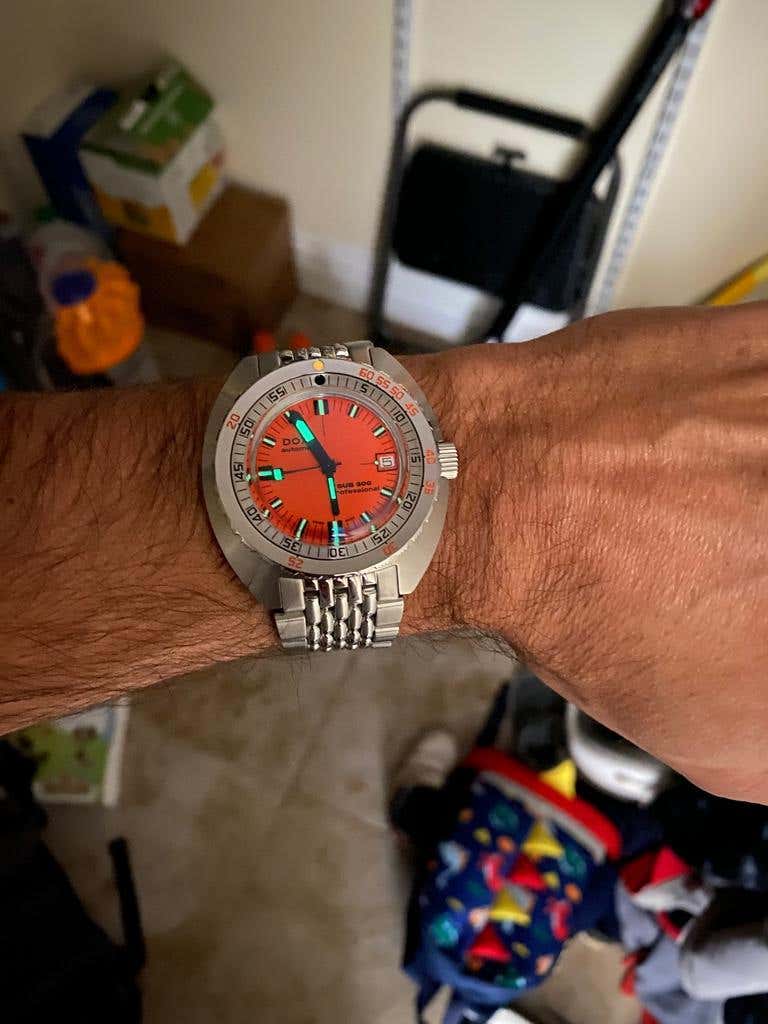
Movement / Winding:
I initially really wanted a 300 because the movement is COSC certified but both feature the exact same ETA movement 2824-2. From what I've gathered in the time with them, they both keep roughly the same time in terms of accuracy.
Let's talk about the winding and setting mechanism because this is where I did notice a difference. The 300t felt much more solid unscrewing, winding, moving the crown positioning and setting. I don't know if this is due to Doxa using a different crown locking system for the 1200 meter water resistance or if it's the different crown? Since the movement is the same, my assumption is that it comes down to one or both of the things I just mentioned. But it feels much more solid. The 300 crown gives an ever so slight "wobble" or "lateral play" when winding, moving positions and setting. My Silver Lung felt the same, so again I think it's the construction and not the movement. The 300 play is barely noticeable and shouldn't deter you at all, but just something I've observed.
Fit on the wrist:
The 300 fits great. It's light weight, barely noticeable and easily slips under the cuff because of the slimmer case and domed crystal. The short lug-to-lug measurements make this really easy to wear for smaller sized wrists and even though the case is 42mm, it wears better than some 40mm watches (ie: chunky 6 digit Rolex subs and GMTs). The smaller dial give it the impression that it is smaller, and the relatively flat caseback keeps it low on the wrist. The bracelet has hinged middle links, which makes the bracelet wrap nicely around the wrist. However, because of this, at times when you look down at your wrist it has this weird flat-top look in my wrist. I'll try to capture this in a photo, but it can look a little weird. (I only bring this up because of different bracelet on the 300t which doesn't give this look.)
While the 300t has the same case lug-to-lug and diameter, it wears different. First, the 300t feels more balanced when looking directly head on. The larger dial and flat crystal for some reason makes it look more balanced or rounded, and the end links of the bracelet (which aren't hinged and are solid and flared out) actually make it look more tapered and again, balanced on the wrist. I know the endlinks were a point of contention with some people and they didn't like the way it looked, but to me, it actually balances the watch out and makes it so you never see that odd flat-top look. The extra thickness and weight are only slightly noticeable first time on wrist. But the heavier bracelet and clasp quickly balance things out the head and it becomes just as unnoticeable and comfortable as the 300 after a little while of wearing.
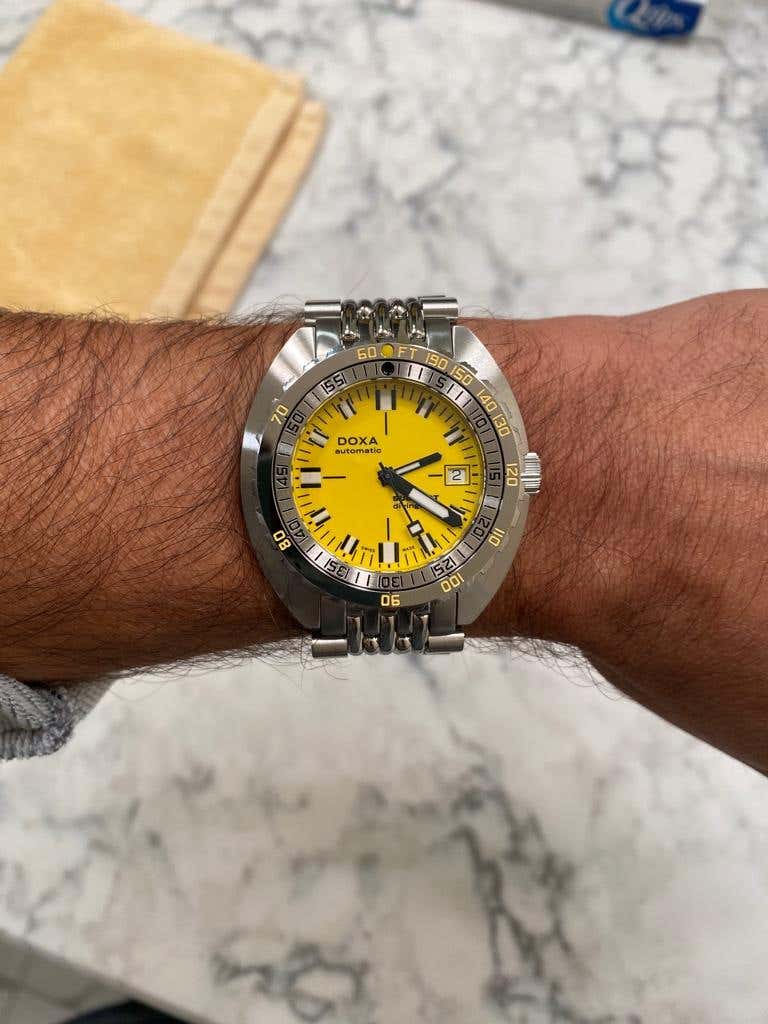

Conclusion:
Both the 300 and 300t are fantastic watches and have a lot to offer from Doxa. If one catches your eye over the other, you couldn't go wrong with either choice. I'm 100% in the buy what you love camp.
But let me focus on pricing for a minute because I didn't even give it a thought until I handled both. The 300t has a lot more to offer for the money. It's $600 less and I could convincingly make the case that it's a much better and more capable watch. IMHO, you're paying extra just for a COSC certification but I would argue that you're not paying just $600 more for it, you're paying probably $1000 more for it. Let me explain, COSC certification is the only thing that's technically "better" than the 300t. The bracelet, HRV+depth rating, clasp, lume, are all hands down better features of the T plus it has the same movement. So take COSC away and theoretically shouldn't the 300 cost less than the 300t? Doxa does have some weird pricing, and this here is a perfect example. Bottom line - for the price the 300t is a steal.
For me, the 300t is the clear winner after a few days of wearing both non-stop. The price coupled with the better construction/quality make it an obvious choice for me. I understand if the endlinks are a dealbreaker for some with smaller wrists, and if that's your issue, then spending an extra $600 for a watch you'll love and really want is a small price to pay. For me I'll be keeping the 300t and I'll make a decision about what to do with the 300 at a later date. I think keeping both in a collection is certainly an option because they are different.
Kudos to Doxa. You've made a more wearable and unique alternative for people who want a capable dive watch like the Rolex SeaDweller but for a fraction of the price.
Thanks for reading! Feel free to post questions and if you want any additional photos I may not have provided.

Sent from my iPhone using Tapatalk






















